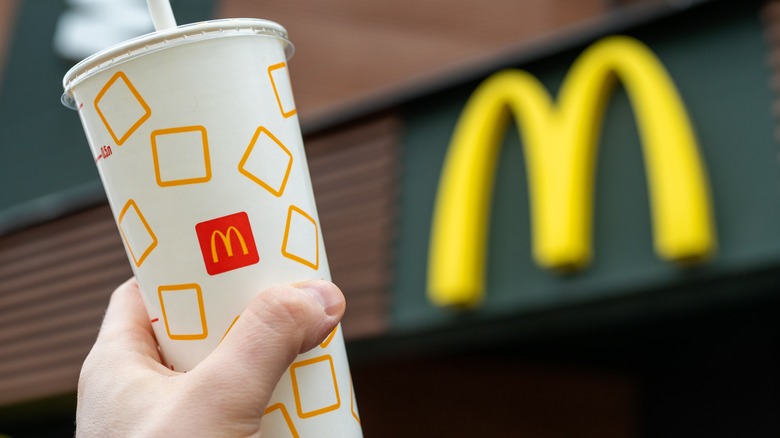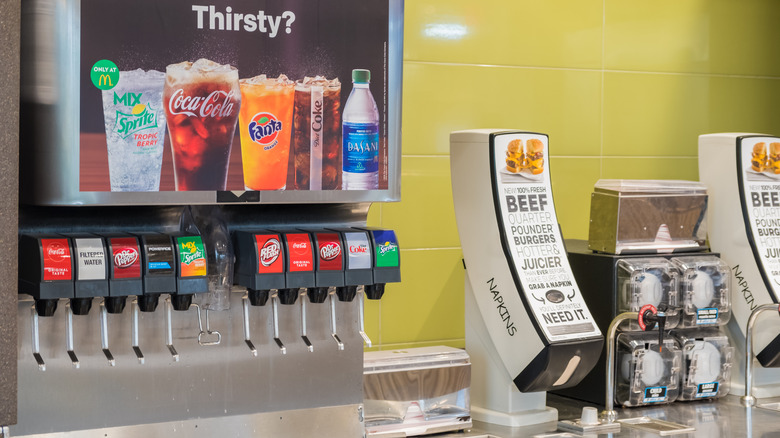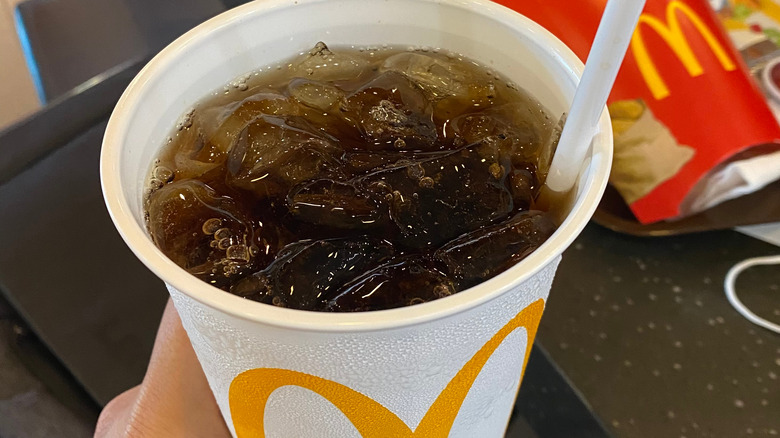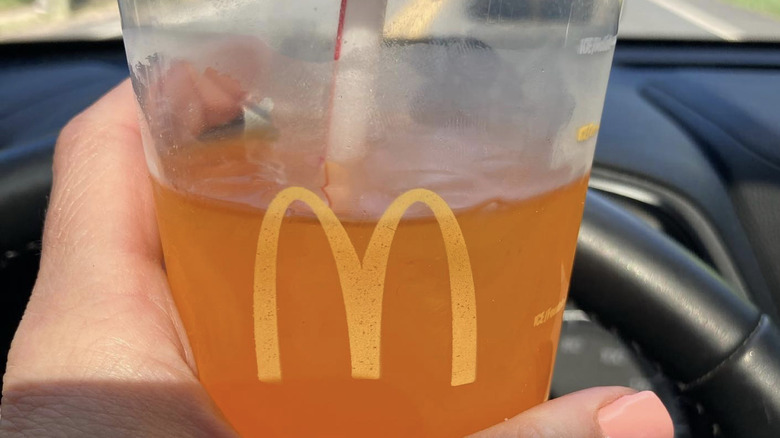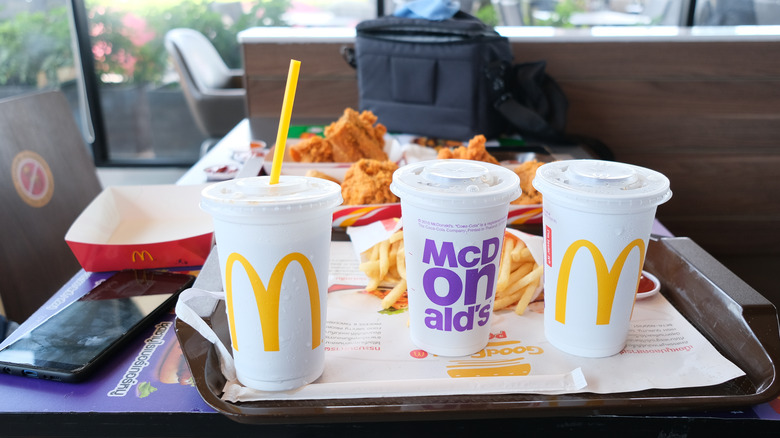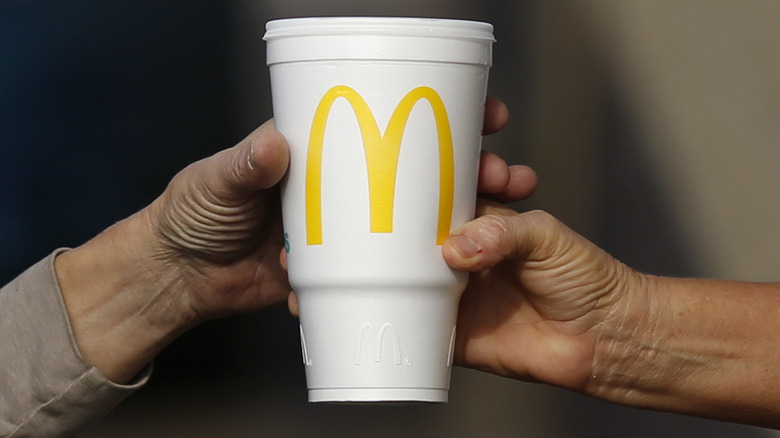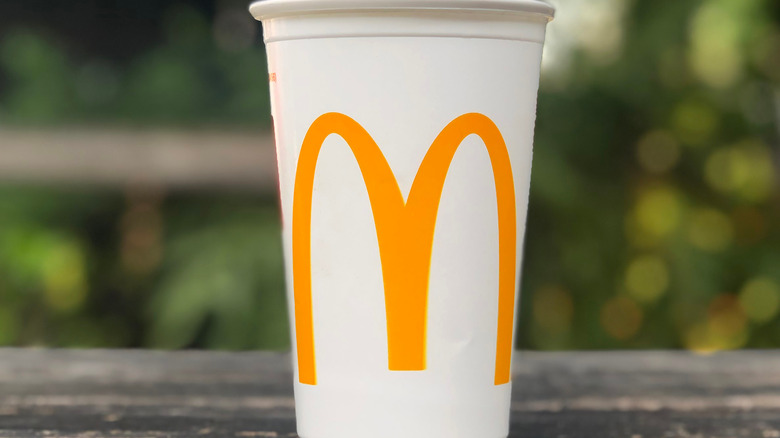The Ultimate Guide To McDonald's Soft Drinks
McDonald's is one of the world's biggest and most influential restaurant chains, proudly proclaiming on its iconic "Golden Arches" signs to have served "billions and billions" of meals. They're successful for a reason, efficiently and consistently cranking out tasty, easy, and comforting food, and a great many of its menu items could make a claim at being its "signature" offering, be it the Big Mac, Quarter Pounder with Cheese, Chicken McNuggets, Egg McMuffin, or those near-universally acclaimed fries.
But no matter what gets ordered from the McDonald's counter or drive-thru window, it needs something to help wash it down, and for millions of customers every day, that's a soft drink. For decades, McDonald's has dispensed Coca-Cola products, like Coke, Diet Coke, Sprite, and more. The drinks are cold, sweet, refreshing, and plentiful, earning the McDonald's soda line as many fans as the food has. It's taken a lot of time and effort for McDonald's to lock down its soft drinks — here's a long sip into the history and mechanics of soda at McDonald's.
McDonald's and Coca-Cola have been partners since the 1950s
In the 1950s, former milkshake maker salesman Ray Kroc had successfully wrestled control of McDonald's, according to Smithsonian, and in 1955 made the first moves toward expanding the small operation into the global fast-food juggernaut it is today. While opening his first restaurant, he sought out a soft drink supplier and contacted Coca-Cola, connecting with Waddy Pratt, the executive in charge of fountain drink sales, according to The New York Times. On their first meeting, they made a handshake deal, with Coke agreeing to supply McDonald's with all of its soft drink needs, an agreement that would eventually encompass thousands of restaurants and last for more than six decades.
McDonald's and Coca-Cola still enjoy an exclusive arrangement, or rather almost exclusive. There are a scarce few rogue McDonald's franchises that dispense Pepsi products out of their fountains. The reason for this is other exclusive contracts that supersede the one between McDonald's and Coca-Cola, such as airports that make deals with Pepsi to be the sole soft drink vendor for every restaurant and food stand under its roof.
McDonald's and Coca-Cola mutually benefit one another
McDonald's sells so many fountain drinks that they helped make a huge difference in the fortunes of Coca-Cola in the early 1980s, according to The New York Times. Shortly after its launch as a canned and bottled drink in 1982, Diet Coke showed up as a drink option at thousands of McDonald's restaurants. Coke was rapidly losing customers to Pepsi at the time, but in 1983, fountain sales of Diet Coke, fueled by McDonald's, raised the entire company's share of the soda market by two whole points, the first time in half a decade that Coke grew faster than Pepsi.
Ten years after McDonald's pushed Coca-Cola to a new level, the soft drink company returned the favor. "Extra Value Meals" — a fixed meal of a sandwich or burger, along with fries and a soft drink, offered at a lower price than it would cost to order each item individually — are standard operating procedure at McDonald's and its competitors now, but they only date back to 1993. McDonald's put the procedure into action after Coke executives gave them the idea, coming up with the idea of selling a burger, fries, and Coke soft drink together during a mutual promotion for "Jurassic Park," according to The New York Times.
Some old favorites disappeared from the McDonald's soft drinks menu
A gigantic red-and-yellow plastic jug bearing the McDonald's logo and used to dispense an ultra-sweet, non-carbonated, orange-flavored soft drink is embedded in the minds of generations of customers, the containers being ubiquitous at restaurants or events throughout the 1980s and 1990s. While rarely clearly displayed, the beverage inside was Hi-C's Orange Lavaburst flavor, available not just in a rented jug at a soccer game or birthday party, but on McDonald's soft drink taps, too. Or at least it was available. After decades on the menu, McDonald's discontinued the item in 2017, slowly phasing it out of its stores over a period of three months, according to Business Insider. However, customer protests were so loud and pointed (including a Change.org petition) that they were effective — according to CNN, McDonald's restored Hi-C Lavaburst to its stores' beverage fountains in early 2021.
Many other soft drinks have come and gone from McDonald's over the years. According to History's Dumpster, Coca-Cola's root beer brand Ramblin' was distributed to fountains until 1995, when the company introduced Barq's Root Beer and favored that variety.
McDonald's beverage cup sizes have changed over the years
Since it became a national entity in 1955, McDonald's menu has changed a lot. When those initial restaurants launched, according to Buzzfeed, they served one size of burger (the item which would now be called just "Hamburger") and a single, modest portion of French fries. In the 21st century, any given McDonald's might offer a couple of dozen items for customers to choose from, with even a selection of beverage sizes from which to choose, an evolution from the original menu. Back in 1955, soft drinks came in just one size — a 7-ounce cup. As of 2022, McDonald's sells four different volumes of soft drinks: the Happy Meal accompanying Child size (12 ounces), a Small (16 ounces), a Medium (21 ounces), and a Large (32 ounces).
In the summer of 1988, according to Mother Jones, McDonald's introduced a limited time Super Size drink promising 42 ounces of Coca-Cola product. McDonald's revived the idea in 1993 as a "Dino Size" option, part of a promotion with "Jurassic Park." It proved so popular that McDonald's made Super Size drinks (and fries) a permanent part of the menu in 1994. There it would remain until 2004, when, after McDonald's faced a lawsuit over it allegedly foisting unhealthy food on the general public and subsequent scrutiny from the critical documentary "Super Size Me," the chain dropped the 42-ounce offering.
Why the soft drinks seem to taste better at McDonald's than they do out of a can
It's simply a matter of opinion and so not quantifiable, but a large swath of people will argue that Coca-Cola products just taste better at McDonald's than they do out of the plastic bottle, aluminum can, or even out of the dispensers at other fast food restaurants. While it's debatable if the methods make for a superior product, it's a fact that Coca-Cola sends its stuff to McDonald's in a unique and exclusive way. According to The New York Times, other restaurants get their supply of syrups from Coca-Cola in plastic bags. McDonald's syrups arrive inside of stainless steel tanks, which reportedly keep the sweet stuff inside as fresh and crisp as possible.
At that point, quality control is up to the individual McDonald's. According to the New York Post, restaurants utilized insulated tubes to dispense Coca-Cola products, which run from a refrigeration unit in the rear of the store to all of its dispensers. McDonald's keeps the soda water as cold as possible without it freezing, between 33 and 38 degrees F, and also uses advanced and thorough water filtration systems.
How can McDonald's profitably sell soft drinks for a $1?
Around 2008, according to Restaurant Dive, McDonald's began experimenting with pricing cold soft drinks and soda at a $1 price point — for every option and every size. The company made that price a permanent one in 2017. While it seems like charging less for a product would mean less money generated, it had the opposite effect. According to Fortune, McDonald's enjoyed a 4% sales increase in 2017 and exceeded earnings expectations, a boost tied directly to the $1 drinks. Those low-priced sodas entice customers to McDonald's, where they may wind up buying additional items.
And it's not like McDonald's is losing much, if any, money by pricing its soft drinks at a cut-rate level. It costs just a few cents in syrup, water, and supplies for McDonald's to sell that Coke for $1, for which it earns a 90% profit margin, according to The Motley Fool.
